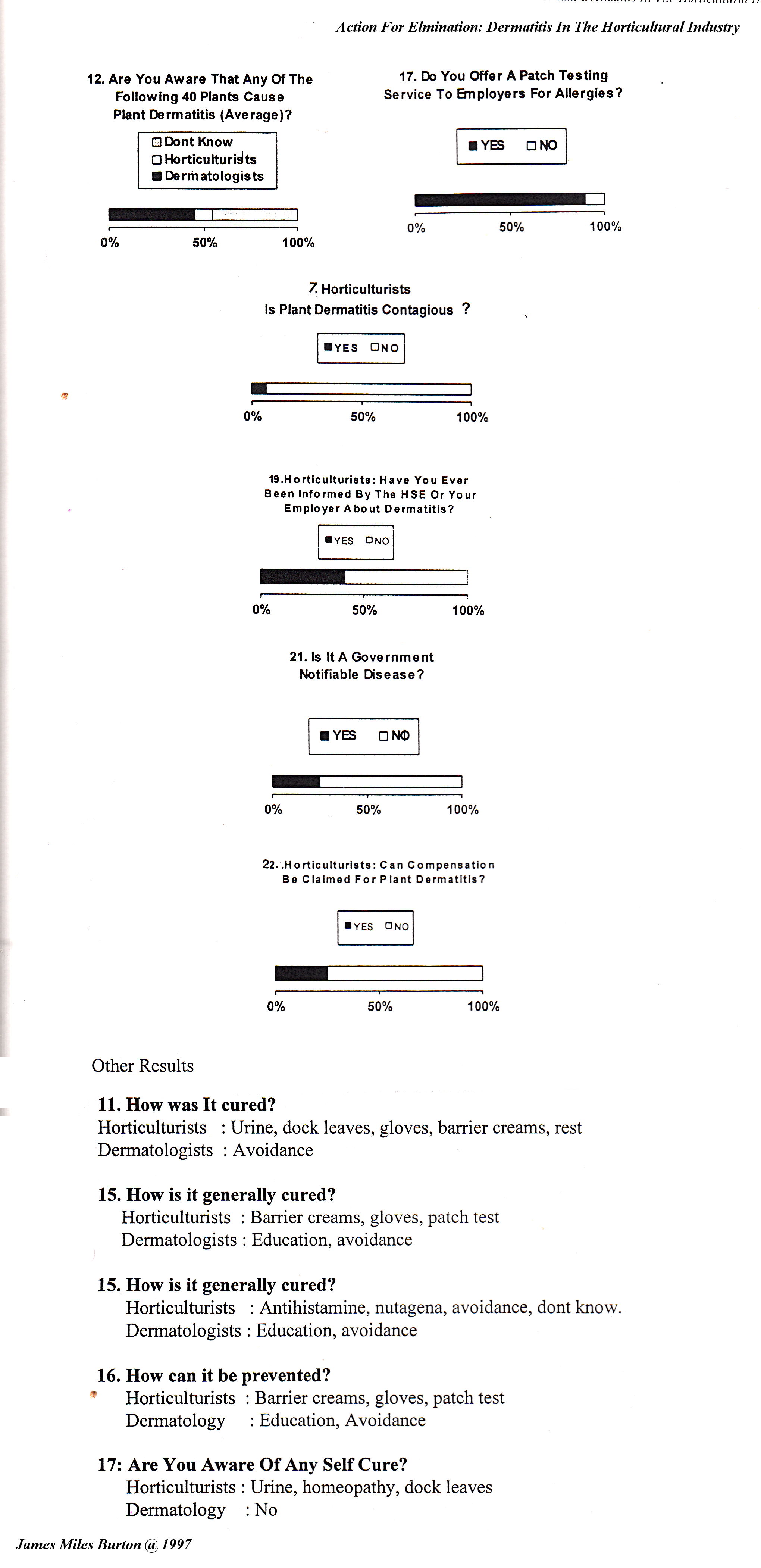|
9.1 Discussion: Questionnaire Results 9.1.1 Workers. If we just glance at these results, we immediately see the levels of ignorance of the affliction in the industry, even in those who have been there for at least 20 years, with a wide knowledge of horticulture. This surprised me, as they were sent to top nurseries and colleges. They had all encountered dermatitis at some point in their lives, from plants and leaves, common varieties often came up, but their knowledge of the allergens, treatment and prevention were poor. One person described urine as being the best cure for nettle dermatitis. The answers were vague and simple. The most common specified prevention for it was gloves. I was surprised to learn that many of them had not been informed, about the dangers of dermatitis either by the Health and Safety or their employers. The only person who had received information was from the National Coal Board in 1970, highlighting danger to timbers underground was particularly concerned that 3/4 of people though that compensation could not be claimed and that it shouldn't be reported. 100% had not even been patch tested for any allergen and some had not even heard of the condition. We are able to deduce that knowledge in the industry is poor, that government does not do its duty in educating people about the disease, and that few know the plants that may cause it, and what they should do to prevent it. It therefore proves my hypotheses that something must be done to educate and prevent the affliction, although it is not HSE fault alone. 9.1.2 Dermatologists I found it so ironic that doctors and Dermatologists new more about the subject of plants and their compounds in Horticulture, than anyone I questioned in Horticulture. They have also spent less time in that particular occupation, and had to deal with a larger variety of types and causes. On average they new of 20 more plants that caused the affliction than horticulturists. I was surprised to see that in contrast with the Hortis who recommend steroids for treatment, they advocated complete avoidance of all medicines, and to heal the skin naturally. They had even told their staff about the dangerous plants they may encounter in the clinic!! They also acknowledge that compensation is difficult to obtain. Therefore the Horticultural industry and the HSE has a lot of catching up to if it is to eliminate or control this affliction, before it becomes an epidemic as in India. It is in their best interests to do so, because it is costing them money. The dermatologists, although best placed to make people aware and treat the disease, cannot do so, because legislation does not recognise it, they are also hypocritical in the fact that they advocate natural healing but use damaging steroids to treat it. Also the dermatologists I have surveyed should not have more knowledge that a horticultural expert, it should be the reverse!! 9.2 Let Us Now Investigate Now that we have proven that plant dermatitis is a significant affliction, and is affecting the well being, health and economy of the industry, primarily through the inadequate of employers and statutory bodies. We must now investigate what the cause of this lack of knowledge is, why legislation is ineffective, why are employees not being protected Why statutory bodies and employers are neglecting their duty to combat the affliction. Is Treatment of the affliction effective? We shall then be able to decide what must be done to combat this predicament, so that employees and industry will benefit from better health, better economy, safest working conditions, better education to eliminate this affliction by the year 2002. Dermatitis In the Horticulture Industry By James M. Burton In Association With Pencoed College Copyright 1997 |
|
9.0 Awareness Of The Affliction
[Questionnaire] I also believe the reason that cases of dermatitis in the industry are so high, is because people are not educated on the subject, are ignorant of the plants that cause it and do not know how to go about protecting themselves. This is because government departments are failing in their duty to educate. For this reason I sent questionnaires to major horticultural nurseries, colleges and retailers in Britain and to every English speaking Dermatology clinic in the U.K. A copy of the questionnaires can be seen in Appendix 4. Response was 40% . I hoped to assess the awareness of those associated within this industry, and those who have to deal with dermatitis. I also wished to prove from this survey that a great deal needs to be done to thoroughly educate everyone concerned with plants about dermatitis, as most are very ignorant on the subject. It will also wish to prove that there is greater incidence of dermatitis than is actually reported, and the HSE and government are negligent in their duties to stamp this affliction out. 9.0.1 Compilation Of Questionnaire Results (Percentage and Averages) |
 |
 |
| Cost |
| Diagnosis |
| Diagnosis |
| Cost |